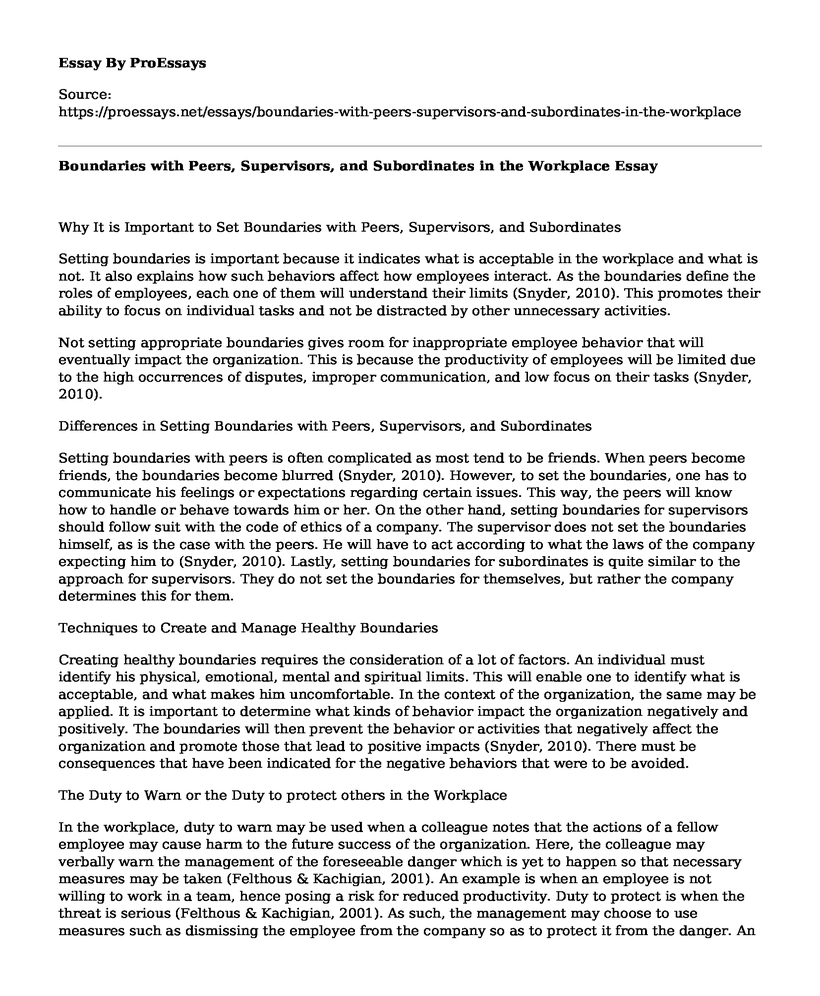Why It is Important to Set Boundaries with Peers, Supervisors, and Subordinates
Setting boundaries is important because it indicates what is acceptable in the workplace and what is not. It also explains how such behaviors affect how employees interact. As the boundaries define the roles of employees, each one of them will understand their limits (Snyder, 2010). This promotes their ability to focus on individual tasks and not be distracted by other unnecessary activities.
Not setting appropriate boundaries gives room for inappropriate employee behavior that will eventually impact the organization. This is because the productivity of employees will be limited due to the high occurrences of disputes, improper communication, and low focus on their tasks (Snyder, 2010).
Differences in Setting Boundaries with Peers, Supervisors, and Subordinates
Setting boundaries with peers is often complicated as most tend to be friends. When peers become friends, the boundaries become blurred (Snyder, 2010). However, to set the boundaries, one has to communicate his feelings or expectations regarding certain issues. This way, the peers will know how to handle or behave towards him or her. On the other hand, setting boundaries for supervisors should follow suit with the code of ethics of a company. The supervisor does not set the boundaries himself, as is the case with the peers. He will have to act according to what the laws of the company expecting him to (Snyder, 2010). Lastly, setting boundaries for subordinates is quite similar to the approach for supervisors. They do not set the boundaries for themselves, but rather the company determines this for them.
Techniques to Create and Manage Healthy Boundaries
Creating healthy boundaries requires the consideration of a lot of factors. An individual must identify his physical, emotional, mental and spiritual limits. This will enable one to identify what is acceptable, and what makes him uncomfortable. In the context of the organization, the same may be applied. It is important to determine what kinds of behavior impact the organization negatively and positively. The boundaries will then prevent the behavior or activities that negatively affect the organization and promote those that lead to positive impacts (Snyder, 2010). There must be consequences that have been indicated for the negative behaviors that were to be avoided.
The Duty to Warn or the Duty to protect others in the Workplace
In the workplace, duty to warn may be used when a colleague notes that the actions of a fellow employee may cause harm to the future success of the organization. Here, the colleague may verbally warn the management of the foreseeable danger which is yet to happen so that necessary measures may be taken (Felthous & Kachigian, 2001). An example is when an employee is not willing to work in a team, hence posing a risk for reduced productivity. Duty to protect is when the threat is serious (Felthous & Kachigian, 2001). As such, the management may choose to use measures such as dismissing the employee from the company so as to protect it from the danger. An example is when an employee is acting as a spy for competitor organizations.
Implementing a Plan to Act on the Duty to Warn or Protect Others in the Workplace
When implementing such a plan, all members of the organization should know about the guidelines. This is important because they will know what to expect from their actions. In addition, when any other employee notices a form of danger, the report will still be made as they will know that it is wrong (Felthous & Kachigian, 2001). The information needs to be disbursed through a selected team of professionals. The team should be developed for the sole purpose of handling such complaints and warnings. The employees will be trained on these factors through workshops organized by the organization. Whenever there are any new recruits, they will be expected to attend a scheduled workshop to give them training on how to identify and report the issues.
References
Felthous, A. R., & Kachigian, C. (2001). To warn and to control: two distinct legal obligations or variations of a single duty to protect?. Behavioral Sciences & The Law, 19(3), 355-373.
Snyder, J. L. (2010). E-Mail Privacy in the Workplace: A Boundary Regulation Perspective. Journal Of Business Communication, 47(3), 266-294. doi:10.1177/0021943610369783
Cite this page
Boundaries with Peers, Supervisors, and Subordinates in the Workplace. (2021, Jun 26). Retrieved from https://proessays.net/essays/boundaries-with-peers-supervisors-and-subordinates-in-the-workplace
If you are the original author of this essay and no longer wish to have it published on the ProEssays website, please click below to request its removal:
- The Case of Newmont Mining in Peru Essay Example
- Essay Example on Apple's Success in China: Merits of Following Procedures
- Self Evaluation Essay: An Analysis of Corporate Social Responsibility and Its Significance and Role in Society
- Essay Sample on Team Building: Appreciate, Understand, Develop & Maximize Team Performance
- Diversity in the Workplace: Understanding Two Dimensions - Research Paper
- Essay on Interprofessional Collaboration: Improving Care Quality and Reducing Hospital Costs
- Essay Example on Creating a Safe Work Environment in High-Risk Industries







